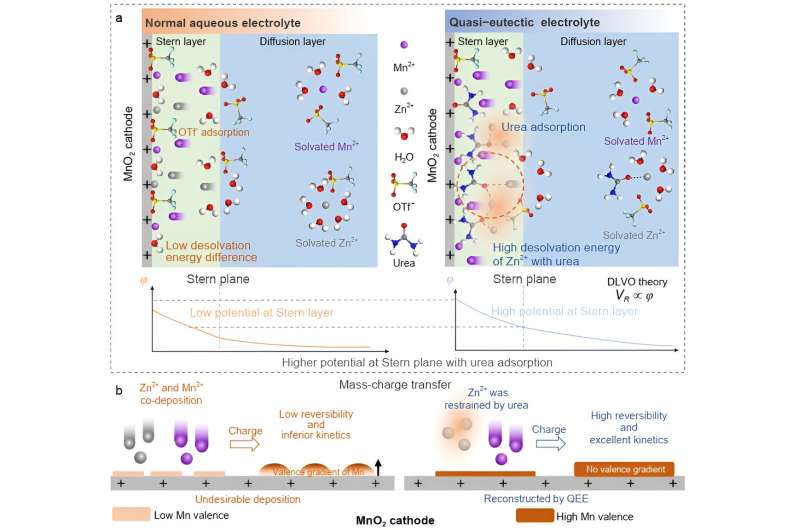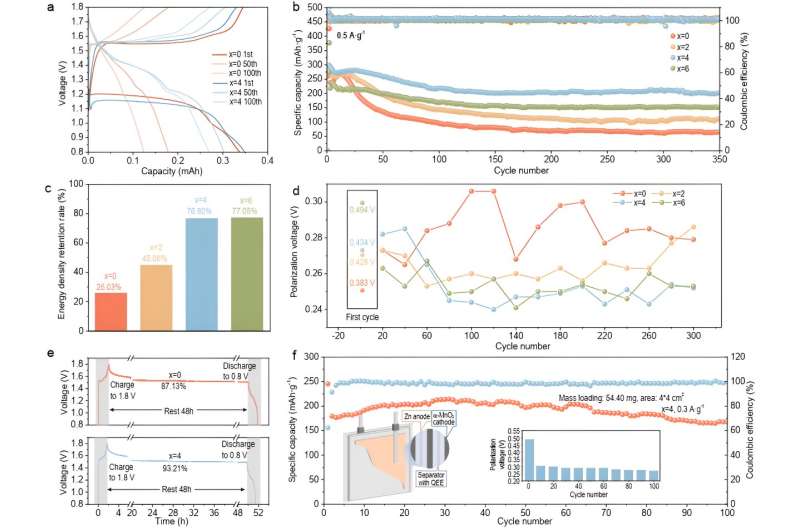This article has been reviewed according to Science X's editorial process and policies. Editors have highlighted the following attributes while ensuring the content's credibility:
fact-checked
trusted source
proofread
Regulating the manganese cathode interface of zinc-manganese batteries with a quasi-eutectic electrolyte

Aqueous zinc-manganese batteries (ZMBs) are increasingly favored as a new type of safe and environmentally friendly battery. However, it has been plagued by capacity degradation induced by conventional aqueous electrolytes (e.g., 2 M zinc salts), which is mainly affected by the uncontrollable Mn dissolution/deposition interfacial reaction.
On the one hand, the solvated structures of Zn2+ and Mn2+ are indistinguishable from each other and have no obvious kinetic properties, leading to competitive reactions and co-deposition to form products such as ZnMn2O4 with lower electrochemical activity.
On the other hand, according to the DLVO theory, the decrease in the potential of the bilayer induced by anion adsorption decreases the interfacial repulsion, which leads to the deposition of agglomerates at the MnO2 anodic interface and the formation of inhomogeneous and irreversible deposition products, which deteriorates the interfacial kinetics during the cycling process.
The group of Prof. Shuquan Liang and Prof. Guozhao Fang from Central South University proposed a new idea of using quasi-eutectic electrolyte to regulate the interface of manganese-based anode. The urea molecules in the quasi-eutectic electrolyte replace the OTf- at the manganese-based anode interface, increase the electrode potential of the anode, change the desolvation kinetics of Mn2+ and Zn2+ at the anode interface, and regulate and induce uniform and reversible interfacial manganese deposition.
Raman and infrared spectra as well as molecular binding energy calculations also demonstrated the strong hydrogen bonding interactions between the CF3 group of OTf- and the NH2 group of urea in the electrolyte. Meanwhile, molecular dynamics calculations show the difference in the solvated structures of zinc and manganese ions in the electrolyte, with urea easily entering the solvated structure of zinc ions and hardly entering the solvation structure of manganese ions.
This difference in solvated structure and the hydrogen bonding interactions in the electrolyte give the quasi-eutectic electrolyte its unique properties (described in more detail below).

Quartz crystal microbalance (QCM-D), Raman spectroscopy, zeta potential, and potential-temperature curves show that in the quasi-eutectic electrolyte, urea displaces OTf- that is originally adsorbed at the cathode interface, thus increasing the electrode. potential at the cathode.
Urea readily enters the solvated structure of the zinc ion but not the solvated structure of the manganese ion. This allows the zinc ions to interact with the urea at the cathode interface, thus limiting the desolvation of the zinc ions. Raman and XPS spectra show that the reduced zinc content of the anode deposition product in the quasi-eutectic electrolyte not only raises the valence of manganese in the deposition, but also inhibits the generation of zinc-manganese oxides with a low degree of reversibility.
In theory, the change of EDL potential can affect the oxidation kinetics at the interface. Ideally, according to the Butler-Volmer equation, the rate of oxidation reaction on the electrode is related to the interface potential. This relationship between the electrode oxidation reaction rate and the Stern plane potential becomes the φ2 effect.
Theoretically the higher the electrode potential φ2, the lower the electrode oxidation reaction rate. Therefore, it can be assumed that the quasi-eutectic electrolyte is unfavorable to the initial kinetics of the cathode. However, the dQ/dV curve shows that although the quasi-eutectic electrolyte is unfavorable to the cathode initial kinetics, the kinetics of the quasi-eutectic electrolyte is better than that of the conventional aqueous electrolyte during the electrode stable cycling.
This is due to the fact that, according to the DLVO theory, the higher electrode potential increases the repulsive force between the deposition, avoids the agglomeration of the deposition, and increases the conductivity of the deposition, which enhances the kinetics.
The concern for manganese-based anode kinetics should not be limited to the initial stage, but more on the stable kinetics during cycling.
The cells containing quasi-eutectic electrolyte have higher capacity retention rate, lower voltage polarization and weaker self-discharge effect. Stable cycles of 350 cycles can be achieved at a current of 0.5 A g-1. Even if installed as a three-layer soft-pack battery, it can still achieve 100 cycles at 0.3 A g-1 current, and the specific capacity is stable at 200 mAh g-1.
The work is published in the journal National Science Review.
More information: Yida Hu et al, Reconstructing interfacial manganese deposition for durable aqueous zinc–manganese batteries, National Science Review (2023). DOI: 10.1093/nsr/nwad220


















